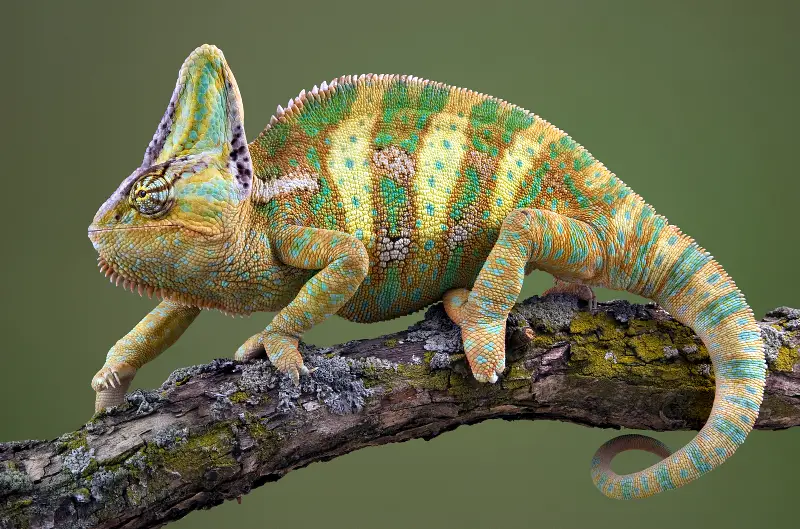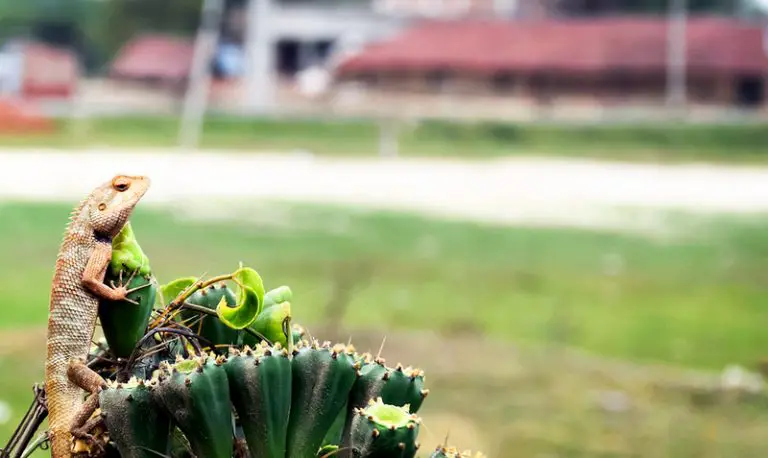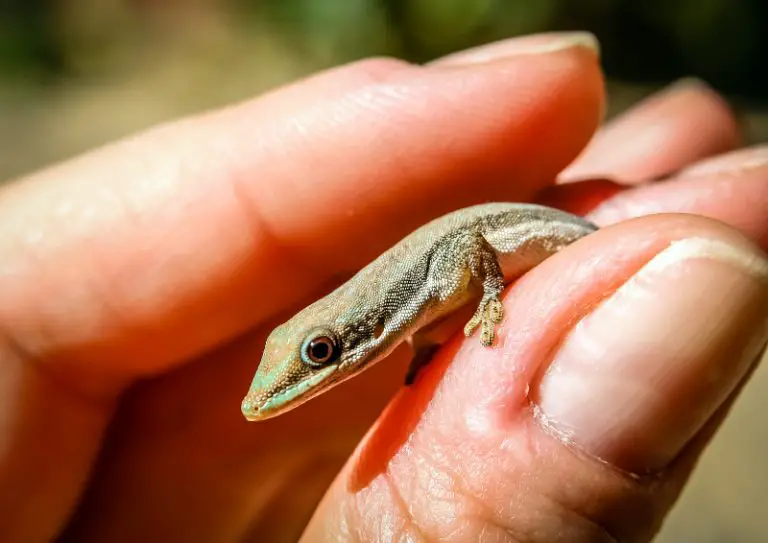How Often Do Veiled Chameleons Eat? [Full Eating Guide]

Veiled Chameleons are one of the largest Chameleons known. So, how often do Veiled Chameleons eat? Despite them being bigger, the answer might surprise you. In this article, we’ll begin with a quick overview of what the Veiled Chameleon is and tips for caring for one. Then, we’ll go more in-depth about their dieting needs.

We’ll discuss how often they need to eat based on their age and how much is appropriate to provide for them. Also, we’ll share a list of the best food for Veiled Chameleons to have. Finally, we’ll share a quick note about not overfeeding your Veiled Chameleons and whether they need supplements or not.
Contents
Table of Contents
What Is A Veiled Chameleon?
Did you know there are 160 species of Chameleons? Veiled Chameleons are just one of them. They are commonly found on coastal plains, mountains, and high deserts in Yemen and Saudi Arabia.
This Chameleon got its name because of the veil on top of its head, which helps them survive the harsh hot weather of these climates. In addition to staying cool, dew drops can collect on the veil and trickle down to the mouth and hydrate them.
Females are typically smaller than males, but Veiled Chameleons are one of the largest of their species. Females can grow up to a foot long, while males can grow up to two feet long. Their average lifespan is about four to six years, with some living about seven years old.
If you get a Veiled Chameleon for a pet, you’ll need a large enclosure that’s well-ventilated. Glass or plastic won’t do. You’ll need a cage that’s screen-sided all the way around.
These Chameleons love to climb, so having a space that’s at least 30 inches tall will allow them to explore and climb to their heart’s content.
Inside their enclosure, you’ll want to add hiding spots, but most of all, plenty of areas to climb. For example, you can add tree branches, logs, or artificial vines. Of course, they’ll also need plenty of artificial or natural plants within their enclosure to mimic their habitat as best as possible.
In addition, Veiled Chameleons need humid and dry temperatures. To help them digest their food, lights and heat with a basking spot through the use of a UVB bulb will help. The basking spot should be about 95 to 100 degrees F.
Overall, Veiled Chameleons are calm and quiet. They’ll make excellent pets, but they prefer to be alone. They’ll become stressed and possibly aggressive if they’re handled too much. When it comes to eating, Veiled Chameleons have a varied diet. So, let’s talk about all the things they can consume.
How Often Do Veiled Chameleons Eat?
Veiled Chameleons will eat less as they grow older. For instance, when they’re six months to a year old, they’re considered juvenile Veiled Chameleons. So they’ll eat less than baby Chameleons but more than adults.
For example, juveniles will eat about one, maybe two meals per day.
On the other hand, when they’re one year old, Veiled Chameleons are considered adults. So, they’ll only need to eat once every other day. Depending on their size and weight, you can get away with feeding adults once every two to three days.
Watch this video: How Often Do Veiled Chameleons Eat
How Often Do Baby Veiled Chameleons Eat?
Baby Veiled Chameleons will eat a lot. This is because they’re considered babies from the time they’re born until about six months of age. Babies grow and develop quickly, so they need an almost constant food source. With that said, you’ll want to be sure to feed your baby Veiled Chameleon about two to three times per day. Once again, depending on their size, you can choose to feed them two or three times per day to ensure they get their nutrients. If you’re unsure how often to feed your baby Veiled Chameleon, check with your vet.
What Can I Feed My Veiled Chameleon?
Veiled Chameleons are omnivores. So, they can eat a wide range of insects, plants, vegetables, and fruits.
A major part of their diet should be live food through insects, but the occasional veggie and plant will give them some added flavor to their meals. Not to mention they’ll give your Veiled Chameleon some more nutrients.
Take a look at the table below for a quick look at all Veiled Chameleons can eat.
| Plants | Vegetables | Fruit | Insects | Treats |
| Endive | Carrots | Pears | Crickets | Mealworms |
| Collard Greens | Squash | Strawberries | Dubia Roaches | Silkworms |
| Mustard Greens | Watercress | Apples | Hornworms | Waxworms |
| Turnip Greens | Sweet Potato | Melons | Butter Worms | Superworms |
| Dandelion Greens | Sweet Red Peppers | Blueberries | Locusts | Bamboo Worms |
| Hibiscus | Zucchini | Raspberries | Phoenix Worms | Pachnoda Grubs |
| Escarole | Cucumber | Blackberries | Flies | |
| Pothos | Broccoli | Grapes | Grasshoppers | |
| Ficus | Bell Peppers | Mango | Wasps | |
| Romaine or Butterhead Lettuce | Kiwi | CalciWorms | ||
| Yams | Orange | |||
| Kale | Tangerines | |||
| Alfafa |
Go more in-depth about what Veiled Chameleons can eat here.
How Much Do Veiled Chameleons Eat?
Veiled Chameleons will need to eat as much as they can within a five-minute time slot. These reptiles are small and will have plenty of time to digest their food before their next feeding.
But how much food should you provide to them for five minutes?
For baby Veiled Chameleons, you should give them about 12 to 18 small crickets per day. Split that into two to three feedings per day. You should only give them about four to six small crickets per meal.
As for juvenile Veiled Chameleons, they need to eat about eight to ten medium-sized crickets per day. You’ll only need to feed them once, but if you give them two meals per day, you can give them about four to five medium-sized crickets per feeding each day.
Finally, adult Veiled Chameleons only need to eat once every couple of days. Because they’re bigger, they’ll eat their food faster. So, within the five-minute time slot during feeding, you can provide them with five to six large crickets at a time.
Can I Overfeed My Veiled Chameleon?
One of the reasons you want to control how much your Veiled Chameleon can consume within five minutes is because it’s easy to overfeed them.
Veiled Chameleons love to eat and don’t know when they stop. So if they see food, they’ll go for it even if they’re not hungry.
Also, it takes Veiled Chameleons a few days to digest their food. So, if you feed them often enough, they won’t have time to digest their previous meal fully.
Overall, overfeeding your Veiled Chameleon can lead to health issues.
For example, they may get kidney or liver problems. It may also lead to a shorter lifespan.
Does My Veiled Chameleon Need Supplements?
The short answer is yes. Veiled Chameleons do need supplements. In fact, they need the following supplements:
- Calcium
- Vitamin A
- Vitamin D3
- Multivitamins
Calcium is a huge part of their diet since it helps support their bone structure and overall growth. Vitamin D3 helps them digest their food. Finally, vitamin A will help their bodies maintain the other vitamins and boost their systems.
You can also give them multivitamins if you’re unsure they’re not getting enough of what they need.
Be sure to contact your vet for the best ways to give your Veiled Chameleon the supplements they need (and to find out which ones your reptile needs).
How To Give Supplements To Your Veiled Chameleon
Supplements may sound like medicine to some, but it’s not. It’s simply something to allow your Veiled Chameleon to get extra nutrients in their system.
There are a couple of different ways to provide supplements for your reptile.
The first way is to go to your local pet store and buy them. For example, there’s calcium powder that you can give to your Chameleon.
Simply sprinkle the powder over your insects, vegetables, and anything you feed your Chameleon. Then, when they eat their food, they’ll get the powder, getting extra nutrients.
Another way you can do it is to gut-load the insects you provide for your Veiled Chameleon. For example, you can feed your crickets or dubia roaches vegetables that are rich in calcium, vitamin A, and vitamin D.
When your Veiled Chameleon eats the insects, they’ll not only get plenty of live protein, but they’ll get a nutrient boost from what the insect ate.
Conclusion
Overall, Veiled Chameleons don’t need to eat much. In fact, it’s pretty easy to overfeed them, and you don’t want that to happen.
Of course, their dieting needs will change as they grow older, which is why it’s essential to know how old your Veiled Chameleon is when you adopt one.
Once you get into a good rhythm with feeding your Veiled Chameleon and find out which foods are their favorite, feeding will be a fun bonding process for both of you.
Learn more about Chameleons here or read our full guide to what chameleons eat in the wild here. You can also read how often all types of Chameleons eat here.

![What Do Baby Chameleons Eat? [Full Guide]](https://allourcreatures.com/wp-content/uploads/2021/11/baby-chameleon-768x513.jpg)



![How Often Do You Feed A Chameleon? [Full Guide]](https://allourcreatures.com/wp-content/uploads/2021/12/chameleon-petting-zoo-768x432.jpg)
![How Fast Do Chameleons Grow? [Must Read]](https://allourcreatures.com/wp-content/uploads/2021/12/Pygmy-Chameleon-001-768x513.jpg)